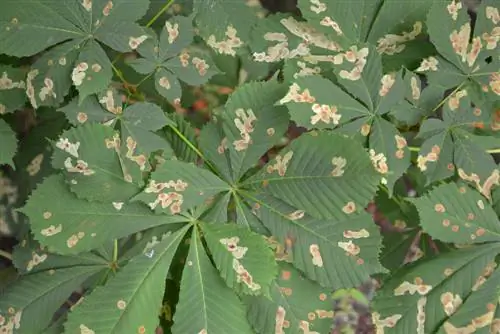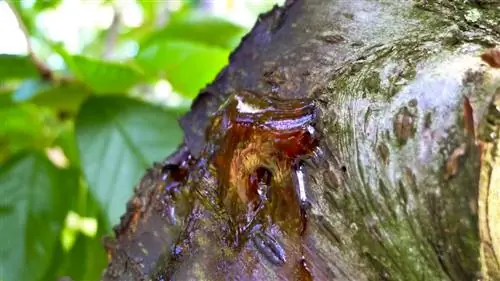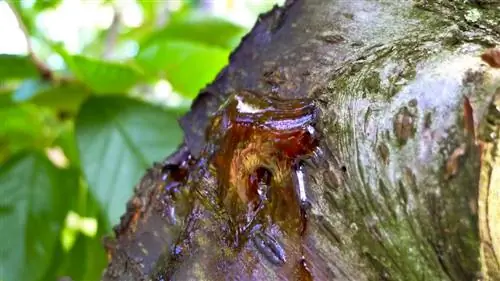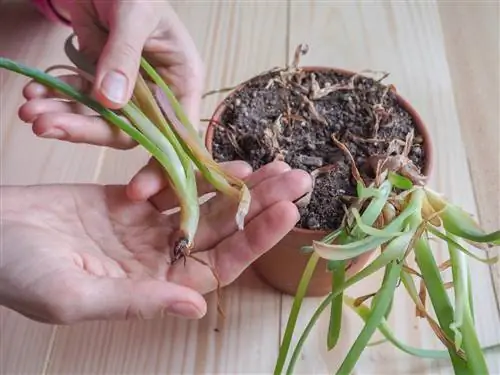- Author admin [email protected].
- Public 2023-12-16 16:46.
- Last modified 2025-06-01 06:02.
Big, imposing and strong - that's how chestnuts look, but they are quite sensitive trees. Even if you don't see it, they are threatened by various diseases and pests. Brown spots on the leaves are often the first sign.
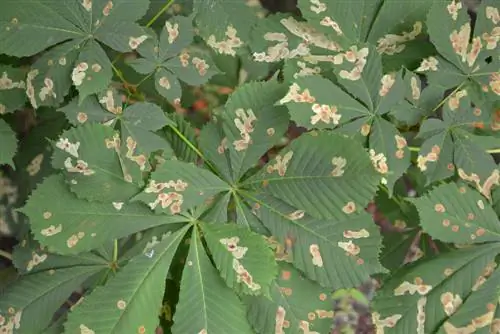
What diseases threaten chestnut trees and how can they be prevented?
Chestnut diseases such as horse chestnut leaf miner, ink disease, Pseudomonas and chestnut bark canker can harm the he alth of the tree. You can prevent this by choosing an optimal location with enough sun, fresh soil and avoiding waterlogging. Pruning can help with fungal infestation.
Which diseases can be dangerous for chestnuts?
The horse chestnut leaf miner primarily attacks the common horse chestnut, but can also occur on other chestnut species. However, unlike a fungal attack, the moth is not fatal to the chestnut tree. Only the leaves are affected, and they wither and fall off early. This is not a particularly pretty sight and weakens the chestnut in the long term. Chestnut moths and chestnut borers, on the other hand, attack the fruits.
Far more dangerous than the horse chestnut leaf miner is the chestnut bark canker, which is caused by a fungal attack and is one of the worst tree diseases, like the so-called bleeding chestnut. A bacterium called Pseudomonas is responsible here. Both diseases attack the bark of the chestnut and can lead to the death of the affected tree.
Ink disease mainly affects the roots of a chestnut tree. Soil that is too moist can promote the spread of this fungal infection. Therefore, waterlogging should be avoided at all costs. The affected roots die and a dark, ink-like liquid comes out. This is how this disease got its name. The trees die after a while, young ones even within a year.
How are plant diseases transmitted?
The transmission routes of plant diseases are different. For example, ink disease can be spread over long distances through contaminated soil that sticks to shoes or vehicle tires. Chicken manure can probably stop the spread. Many germs and fungal spores penetrate the plant through small injuries, which is why you should proceed carefully when cutting your chestnut and only use thoroughly cleaned tools.
Can I prevent chestnut diseases?
If a chestnut feels comfortable in its location, then the chance of he alth is greatest. It should be placed as sunny as possible, in fresh, not too moist soil. Although it is often planted as a street tree, it reacts quite sensitively to winter s alt spreading. This weakens it and makes it more susceptible to various pathogens, such as fungal infections and bacteria.
What you need to know about chestnut diseases and pests:
- Horse chestnut leaf miner: annoying, weakens the tree, not fatal
- Ink disease: attacks the roots, easily transmitted, fatal
- Pseudomonas: attacks the bark, can lead to death
- Chestnut bark cancer: attacks the bark, with generous pruning the tree's chances of survival increase
- Chestnut borer: attacks the fruit, leads to crop failure
- Box moth: attacks the fruits, leads to crop failure
Tip
If there is a fungal infection, a generous pruning may be able to save your chestnut. However, you have to react quickly and cut right into the he althy wood.

